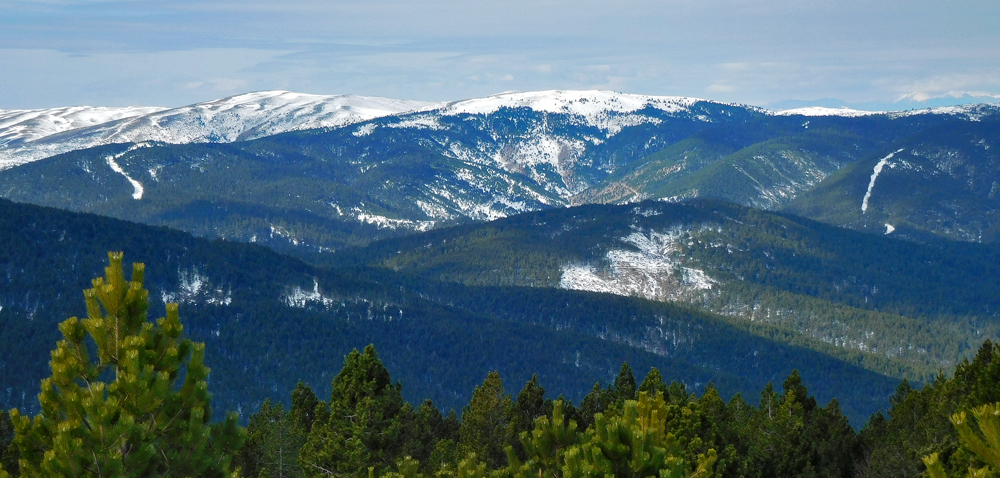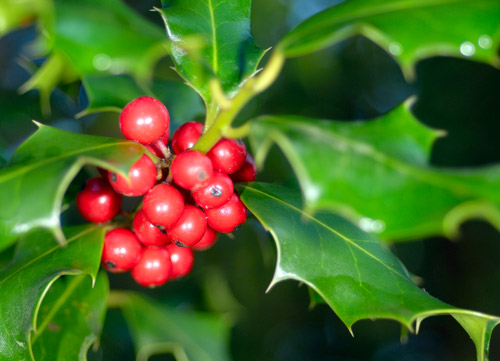Mountains
Vardousia

Vardousia mount is characterised by a big number of impressive peaks and extensive alpine meadows which hold one of the richest flora biodiversity in Greece. It is the largest mountainous complex of Sterea Hellas region as it stretches over an area of about 220 sq.km. Vardousia mount is located in the central part of Roumeli region and stretches to the northwest of Phokida prefecture with a small part entering the southwest of Phthiotis prefecture. In previous decades the mountain was called Korax or Korakas (Raven) from the name of its highest peak. To the west it is bordered with the Nafpaktia mountains, to the east with Giona mount, to the south with the lake of Mornos and to the north is joined with Oeta and Oxia mounts, while at the foothills is embraced by the big Mornos river. Vardousia mount has more than 40 peaks exceeding 2,000 meters. The most important of them are Korakas (2,495 m), Kokkinias (2,404 m), Ornio (2,287 m), Korakia (2,148 m) and Trapezaki (1,862 m) to the south, Plaka (2,348 m) m.), Alogorachi (2,265 m), Soufles (2,260 m), Kostaritsa (2,216 m) and Gidovouni (2,087 m) to the west and Chomiriani (2,294 m), Sinani (2,055 m) and Omalos (1,832 m) to the north. Dozens of springs create streams and rivers such as Karyotiko, Saitas and Kalogeriko streams that flow into Evinos river, Kokkinos river, Granitsorema stream and Vourlorema, Arkoudorema, Milias and Kanavorema streams that flow into Mornos. The geological character of the mountain is composed mainly from limestone with a scarce presence of flysch and cherts. It is a mountainous area characterised by many pointed peaks, vertical slopes, fir forests, big screes, countless streams and a vast alpine plateau. Famous are the subalpine plains in Mousouniotika meadows, Artotiana meadows and Vostinitsiotika pastures that embrace the highest peaks of Vardousia. More than most greek mountains, Vardoussia is distinguished by a particularly intense relief with landscapes similar to those of Alps. It is no coincidence that the mountain was a rebel stronghold during the Greek Revolution and even today it is famous for its rough routes. The morphology of the mountain creates ideal habitats for a great number of rare plants, therefore the Vardousia mount is a famous top destination for many botanists and amateur plant enthusiasts.
The flora species, recorded to date in the area, reach the number of 1,200. Approximately 110 of them are endemic to Greece and 4 are local endemics, while new references are added every year, due to the endless unexplored spots. At low altitudes around Mornos lake dominates the Mediterranean maquis with representatives like kermes oak, green olive tree, greek strawberry tree and oriental plane around the streams. Going higher starts the zone with the mixed forests of various oaks, elms, sweet chestnuts and other deciduous trees. From 1,000 meters begins the big forest of greek and bulgarian fir covering over 40% of the total area of Vardousia. Above the fir zone, from 1,700 meters upwards, begins the subalpine and alpine vegetation with extensive meadows interrupted by small shrubs and the frequent presence of foetid juniper (Juniperus foetidissima). The four local endemics of the mountain are Achillea barbeyana, Alyssum nebrodense subsp. tenuicaule, Campanula columnaris and Cephalaria glaberrima. Some of the rare greek endemics are Asperula boissieri, Astragalus hellenicus, Astragalus sempervirens subsp. cephalonicus, Verbascum reiseri, Campanula topaliana subsp. delphica, Campanula radicosa, Campanula rupicola, Cirsium heldreichii subsp. heldreichii, Arabis subflava, Dianthus diffusus, Dianthus haematocalyx subsp. ventricosus, Dianthus tymphresteus, Rindera graeca, Halacsyella parnassica, Erysimum graecum, Genista milli, Geocaryum parnassicum, Inula verbascifolia subsp. parnassica, Minuartia juniperina, Ornithogalum fimbriatum subsp. gracilipes, Aubrieta gracilis, Alkanna calliensis and Veronica sartoriana. Other important species in the area are Silene auriculata, Silene barbeyana, Silene congesta, Telephium imperati subsp. orientale, Thymus hartvigii, Astragalus suberosus subsp. haarbachii, Asperula oetea, Centaurea nervosa subsp. promota, Colchicum graecum, Paronychia polygonifolia, Saxifraga spruneri, Rhamnus sibthorpianus, Cynoglottis barrelieri subsp. serpentinicola, Fritillaria thessala subsp. thessala, Gentiana lutea, Pedicularis graeca, Saxifraga sibthorpii, Sempervivum marmoreum subsp. marmoreum, Geum heterocarpum, Rhynchocorys elephas, Omphalodes luciliae, Lilium chalcedonicum, Crocus veluchensis, Viola aetolica, VIola graeca and VIola poetica. Some of the Vardousia orchids are Cephalanthera rubra, Dactylorhiza baumanniana, Dactylorhiza saccifera, Gymnadenia conopsea, Neottia ovata, Anacamptis boryi, Anacamptis laxiflora, Orchis provincialis, Orchis mascula, Orchis pallens, Ophrys spruneri, Ophrys hebes and Ophrys zeusii.
The flora species, recorded to date in the area, reach the number of 1,200. Approximately 110 of them are endemic to Greece and 4 are local endemics, while new references are added every year, due to the endless unexplored spots. At low altitudes around Mornos lake dominates the Mediterranean maquis with representatives like kermes oak, green olive tree, greek strawberry tree and oriental plane around the streams. Going higher starts the zone with the mixed forests of various oaks, elms, sweet chestnuts and other deciduous trees. From 1,000 meters begins the big forest of greek and bulgarian fir covering over 40% of the total area of Vardousia. Above the fir zone, from 1,700 meters upwards, begins the subalpine and alpine vegetation with extensive meadows interrupted by small shrubs and the frequent presence of foetid juniper (Juniperus foetidissima). The four local endemics of the mountain are Achillea barbeyana, Alyssum nebrodense subsp. tenuicaule, Campanula columnaris and Cephalaria glaberrima. Some of the rare greek endemics are Asperula boissieri, Astragalus hellenicus, Astragalus sempervirens subsp. cephalonicus, Verbascum reiseri, Campanula topaliana subsp. delphica, Campanula radicosa, Campanula rupicola, Cirsium heldreichii subsp. heldreichii, Arabis subflava, Dianthus diffusus, Dianthus haematocalyx subsp. ventricosus, Dianthus tymphresteus, Rindera graeca, Halacsyella parnassica, Erysimum graecum, Genista milli, Geocaryum parnassicum, Inula verbascifolia subsp. parnassica, Minuartia juniperina, Ornithogalum fimbriatum subsp. gracilipes, Aubrieta gracilis, Alkanna calliensis and Veronica sartoriana. Other important species in the area are Silene auriculata, Silene barbeyana, Silene congesta, Telephium imperati subsp. orientale, Thymus hartvigii, Astragalus suberosus subsp. haarbachii, Asperula oetea, Centaurea nervosa subsp. promota, Colchicum graecum, Paronychia polygonifolia, Saxifraga spruneri, Rhamnus sibthorpianus, Cynoglottis barrelieri subsp. serpentinicola, Fritillaria thessala subsp. thessala, Gentiana lutea, Pedicularis graeca, Saxifraga sibthorpii, Sempervivum marmoreum subsp. marmoreum, Geum heterocarpum, Rhynchocorys elephas, Omphalodes luciliae, Lilium chalcedonicum, Crocus veluchensis, Viola aetolica, VIola graeca and VIola poetica. Some of the Vardousia orchids are Cephalanthera rubra, Dactylorhiza baumanniana, Dactylorhiza saccifera, Gymnadenia conopsea, Neottia ovata, Anacamptis boryi, Anacamptis laxiflora, Orchis provincialis, Orchis mascula, Orchis pallens, Ophrys spruneri, Ophrys hebes and Ophrys zeusii.
The avifauna is also rich in the area with many predators nesting on the cliffs. Vardousia is one of the last habitats in mainland Greece, where, until a few decades ago, the bearded vulture and the griffon vulture were thriving. Birds of prey include golden eagles, short-toed snake eagles, booted eagles, common buzzards, honey buzzards, peregrines, sparrowhawks, levant sparrowhawks, northern goshawks, kestrels and hobbies. From the alpine meadows to the peaks live birds like, horned larks, rock thrushes, ring ouzels, alpine accentors, wallcreepers, yellow-billed choughes, ortolan buntings and white-winged snowfinches. Other birds that you can meet in Vardousia are rock partridges, woodcocks, wood pigeons, cuckoos, tawny owls, eagle owls, little owls, nightjars, alpine swifts, red-rumped swallows, crag martins, black woodpeckers, green woodpeckers, great spotted woodpeckers, woodlarks, dippers, redstarts, song thrushes, mistle thrushes, coal tits, sombre tits, long-tailed tits, common whitethroats, firecrests, goldcrests, nightingales, treecreepers, nuthatches, red-backed shrikes, woodchat shrike, jays, ravens, bramblings, linnets, siskins, hawfinches, red crossbills, rock buntings and cirl buntings.
The amphibians include alpine newts, fire salamanders, common toads, yellow-bellied toads, agile frogs and greek stream frogs. The mountain is a paradise for reptiles like, Hermann’s tortoises, marginated tortoises, greek slow worms, glass lizards, dalmatian algyroides, common wall lizards, balkan green lizards, balkan wall lizards, smooth snakes, caspian whipsnakes, four-lined snakes, balkan whip snakes, Dahl’s whip snakes, grass snakes, european ratsnakes and long-nosed vipers. The mammal fauna include wolfs, wild cats, wild boars, roe deers, red foxes, otters, badgers, pine martens, weasels, red squirrels, brown hares, hedgehogs, edible dormouses and forest dormouses. The protagonist, however, of the fauna of Vardousia is the chamois, whose presence here is the southest european distribution of the species. This proud mammal has been hunted for decades here but there are still a few groups that live close to the peaks of Vardousia.
The amphibians include alpine newts, fire salamanders, common toads, yellow-bellied toads, agile frogs and greek stream frogs. The mountain is a paradise for reptiles like, Hermann’s tortoises, marginated tortoises, greek slow worms, glass lizards, dalmatian algyroides, common wall lizards, balkan green lizards, balkan wall lizards, smooth snakes, caspian whipsnakes, four-lined snakes, balkan whip snakes, Dahl’s whip snakes, grass snakes, european ratsnakes and long-nosed vipers. The mammal fauna include wolfs, wild cats, wild boars, roe deers, red foxes, otters, badgers, pine martens, weasels, red squirrels, brown hares, hedgehogs, edible dormouses and forest dormouses. The protagonist, however, of the fauna of Vardousia is the chamois, whose presence here is the southest european distribution of the species. This proud mammal has been hunted for decades here but there are still a few groups that live close to the peaks of Vardousia.
Πως θα πάτε
Vardousia lay 260 km from Athens. The route runs in the Athina-Lamia Highway and exits at Bralos. From there begins a beautiful road that passes through dense forests and ends at the village of Athanassios Diakos, the closest one to the highest peaks of the mountain. If you come from the north you turn to Lamia and after about 30 km, turn to Sperchiada and head towards the villages of Grammeni Oxia and Artotina, located to the northwest of the mountain.Εμφάνιση στο χάρτη
click to see the place on the map(Latitude: 38.69107944843368, Longitude:22.127772837527573)
Social Networks
Also Read

Vermio
A big mountain with gentle slopes and many peaks that dominates among the plains of central Macedonia and is distinguished by the presence of many rare species of flora and fauna.

Lefka Ori (White Mountains)
The imposing mountain mass of Western Crete, with the unearthly Madares, as the alpines of Lefka Ori are called, is one of the largest habitat for the endemic flora of Greece, which attracts the interest of dozens of botanists of the planet.













